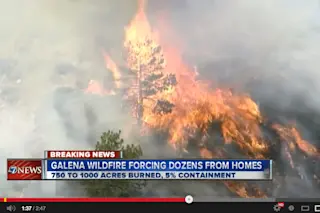Driven by winds up to 45 miles per hour, the Galena fire west of Fort Collins, Colorado spread to about 1,000 acres on Friday night. Fire season out here in the West is supposed to begin in May. But that didn't stop a nasty wildfire from blowing up yesterday about 45 minutes north of where I live. With continuing drought, low snowpack, record high temperatures in the mid-70s, and strong winds gusting as high as 45 miles per hour, all it took was an ignition to get a wildfire off and running. By nightfall the fire had spread to about 1,000 acres, and as I write this it is only 5 percent contained. Although authorities have not yet provided the specifics, they have reported that it was human-caused. The Galena Fire is probably a harbinger of another bad fire season to come, following close on the heels of 2012, which ...
Ready... Set... Burn.
The Galena fire in Colorado has rapidly spread to 1,000 acres, highlighting severe drought conditions and rising wildfire activity in the West.
More on Discover
Stay Curious
SubscribeTo The Magazine
Save up to 40% off the cover price when you subscribe to Discover magazine.
Subscribe













